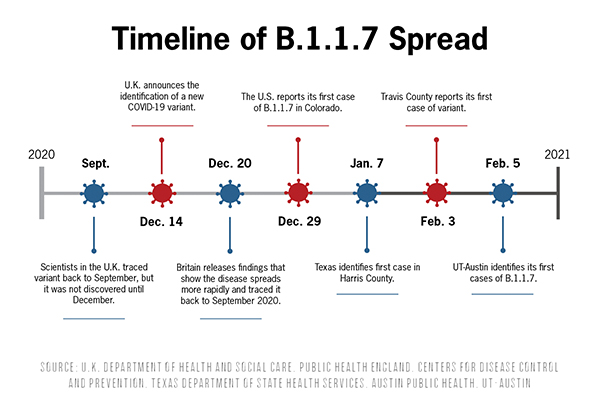B.1.1.7, the COVID-19 variant first identified in the United Kingdom, found its way to UT’s campus Feb. 5, and as of Feb. 11, UT has identified four cases of B.1.1.7.
The new variant spreads faster than the current circulating strain and is expected to become the dominant coronavirus variant in the United States by March, according to the Centers for Disease Control and Prevention. The first B.1.1.7 case in the U.S. was reported on Dec. 29, and by Jan. 7, it was in Texas. Travis County first identified a case of the variant on Feb. 3.
Amy Young, chief clinical officer for UT Health Austin, said UT expects the number of B.1.1.7 cases to increase. Young said the University plans to strengthen health and quarantine guidelines.
Young said UT will soon announce new health recommendations for people to double mask using a surgical mask underneath a cloth mask. The recommendation is partially because of the variant, but also because of new CDC recommendations, she said.
UT also plans to remove the opportunity for COVID-19 positive patients to test out of quarantine, Young said. The University previously allowed people who were in recommended 10-day quarantines to leave early if they tested negative on day eight.
“Until we know a little bit more about (the variant), we want to take a conservative approach and not offer testing to get out early,” Young said.
Ilya Finkelstein, associate professor of molecular biosciences, said B.1.1.7 seems to be 40-50% more transmissible, which could overrun health care systems and lead to more deaths if the variant is widespread.
British scientists have found evidence that B.1.1.7 is slightly more deadly, and a mutation known as E484K in the strain could make vaccines less effective. Austin Public Health officials have said they believe current vaccines will work against the variant.
“I think concerns about vaccine efficacy are a little overblown at the moment,” Finkelstein said. “The data’s not fully in, but it sure looks to me like vaccine efficacy is still very high for these circulating variants.”
The variant possibly spreads more easily because of mutations in the virus’ spike protein, Finkelstein said. He said the spike protein acts like a “molecular key” to unlock the human cell, and the variant’s mutation makes it a better “key” to increase transmissibility.
Finkelstein said scientists don’t fully understand what makes the virus more transmissible.
One leading hypothesis for how the B.1.1.7 variant formed was after the virus infected an immunocompromised person and persisted for months, he said.
Multiple variants of COVID-19 are circulating, but health officials and experts are mainly watching three: B.1.351 from South Africa, P.1 from Brazil and B.1.1.7 from the U.K.
To detect B.1.1.7, scientists use a sequencing machine to determine a positive COVID-19 sample’s DNA. UT started this process, which takes one to two weeks, in January, said Andreas Matouschek, associate dean for research and facilities in the College of Natural Sciences. The University expects to finish analyzing January’s samples the week of Feb. 14, he said.
“We, as everybody else, saw that the virus was mutating,” Matouschek said. “(UT) wanted to know when these viruses were coming to campus so we could be able to respond better.”
Editor's Note: This story first appeared in The Daily Texan's February 12 print edition.





















